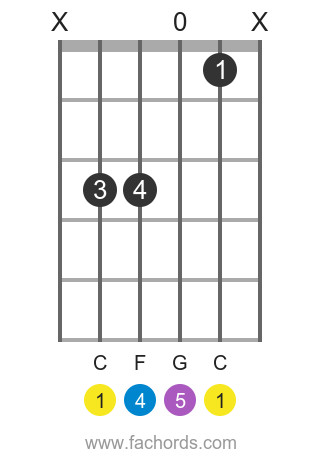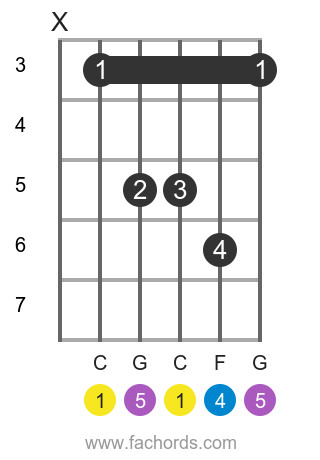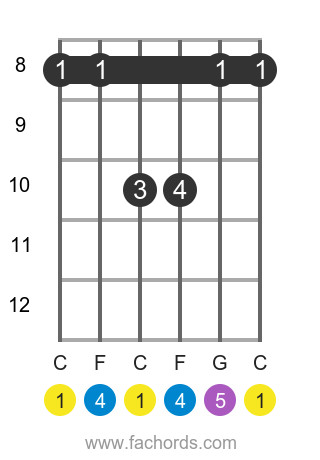The Csus4 chord is a fascinating and versatile chord in the guitarist’s toolkit. Stepping outside the realm of basic major and minor chords, the Csus4, or C suspended 4th, offers a unique sonic flavor that can add depth and interest to your playing. This chord belongs to the family of suspended chords, characterized by the absence of the typical third interval, replaced instead by a perfect fourth. In the case of Csus4, this means it’s built from the notes C, F, and G, based on the 1st, 4th, and 5th intervals of the C major scale – Root, Perfect Fourth, and Perfect Fifth.
If you’re just beginning your journey into music theory and chord construction, understanding intervals is key. We highly recommend exploring resources that delve into building chords through stacked intervals to solidify your foundation. This knowledge will make grasping the Csus4 and other suspended chords much more intuitive.
For those already comfortable with music theory, you’ll appreciate how the Perfect Fourth interval gives the Csus4 its characteristic “suspended” sound. This creates a feeling of anticipation and openness, distinct from both major and minor chords. To deepen your understanding of intervals, exploring dedicated materials on fretboard intervals can be incredibly beneficial.
Learning the Csus4 chord is a significant step for guitarists looking to move beyond beginner-level chords. It’s a widely used chord across various musical genres, from pop and rock to folk and jazz. Mastering it opens up a wider range of harmonic possibilities and expands your songwriting and improvisational palette. If suspended chords intrigue you, further exploration into the world of suspended guitar chords will be rewarding.
Once you’ve become proficient with the Csus4 chord, consider using interactive tools that can analyze chord shapes on the fretboard. This is an excellent way to test your understanding and confirm you are accurately playing the chord in its different positions.
Let’s now dive into the practical aspects of playing the Csus4 chord and explore its various positions on the guitar.
Understanding the Notes of the Csus4 Chord
As mentioned, the Csus4 chord is composed of three notes:
- C – Root (1)
- F – Perfect Fourth (4)
- G – Perfect Fifth (5)
These notes create the suspended quality, replacing the major or minor third with the fourth interval.
Suspended Fourth Chord Formula
The formula for any Suspended Fourth chord is characterized by the intervals: 1, 4, and 5. While some resources might list a b2, b3, #5, b7, etc. in a broader chord formula table, for a Sus4 chord specifically, we focus on the 1 – 4 – 5 intervals.
Csus4 Chord Positions on the Guitar
Chord diagrams are read from left to right representing the strings from the 6th (thickest, lowest E) to the 1st (thinnest, highest E). The numbers or symbols indicate which frets to press and which fingers to use. “X” means the string is not played, and “O” means the open string is played.
Let’s explore some common positions for playing the Csus4 chord.
Position 1: Open Position
This is often the easiest and first position to learn for the Csus4 chord.
 C sus4 position 1 guitar chord diagram
C sus4 position 1 guitar chord diagram
In this open position:
- 1st finger (index finger) is on the 2nd string, 1st fret (F note).
- 2nd finger (middle finger) is on the 4th string, 2nd fret (C note).
- 3rd finger (ring finger) is on the 5th string, 3rd fret (G note).
- The 6th string is not played (X).
- The 1st and 3rd strings are played open (G and E respectively, both contributing to the chord sound).
This position is excellent for beginners and sounds full and resonant. The alt text for this image is: “Csus4 chord diagram position 1 open, showing finger placement for root, fourth, and fifth notes on guitar fretboard.”
Position 2: Barre Chord (Movable)
This position is a barre chord shape, making it movable up and down the neck to play other sus4 chords.
 C sus4 position 2 guitar chord diagram
C sus4 position 2 guitar chord diagram
For this barre chord position:
- 1st finger (index finger) bars across all six strings at the 3rd fret.
- 3rd finger (ring finger) is on the 5th string, 5th fret.
- 4th finger (pinky finger) is on the 4th string, 5th fret.
- The 2nd finger is not used in this particular voicing to allow for a clearer sound.
This shape is based on a movable F barre chord shape. Barre chords can be challenging initially, so practicing barre chord techniques and tips will be beneficial. The alt text for this image is: “Csus4 chord diagram position 2 barre, illustrating movable shape with root on 5th string for guitarists.”
Position 3: Barre Chord (Movable)
Here’s another movable barre chord position for Csus4, offering a different voicing.
 C sus4 position 3 guitar chord diagram
C sus4 position 3 guitar chord diagram
In this position:
- 1st finger (index finger) bars across the top five strings at the 8th fret.
- 2nd finger (middle finger) is on the 3rd string, 10th fret.
- 3rd finger (ring finger) is on the 2nd string, 10th fret.
- The 6th string is not played (X).
This barre chord shape is higher up the neck and provides a brighter tone. Like position 2, this is also a movable shape. The alt text for this image is: “Csus4 chord diagram position 3 movable barre, depicting higher fretboard voicing for guitar chord practice.”
You can find even more positions and voicings for the Csus4 and other chords in comprehensive online guitar chord libraries. Printable guitar chord charts can also be helpful resources for practice.
Csus4 Chord in Musical Context
The Csus4 chord is commonly used in various musical genres to create a sense of suspension and resolution. It often resolves to a C major chord, creating a satisfying musical phrase. You’ll find it in:
- Pop and Rock: Used for intros, verses, and bridges to add harmonic interest.
- Folk Music: Provides a gentle, open sound that complements folk melodies.
- Jazz: Used in jazz progressions to create a sophisticated harmonic texture.
Experiment with incorporating the Csus4 chord into your songs and progressions to explore its unique sonic qualities.
Explore Other Root Suspended 4th Chords
Once you’re comfortable with Csus4, try playing sus4 chords with different roots. Understanding the movable barre chord shapes will allow you to easily play Dsus4, Esus4, Fsus4, Gsus4, and many others. This expands your harmonic vocabulary and fretboard knowledge significantly.
Conclusion
The Csus4 guitar chord is a valuable addition to any guitarist’s repertoire. Its suspended sound offers a refreshing alternative to major and minor chords and is used extensively across musical styles. By mastering these positions and understanding the theory behind it, you’ll enhance your playing and musical expression. Keep practicing and exploring the versatility of the Csus4 chord!
